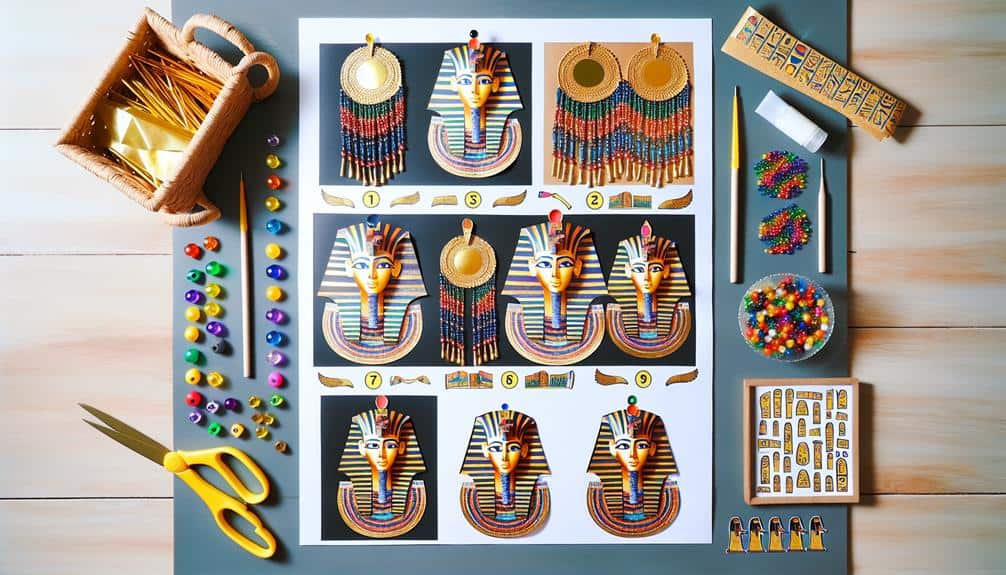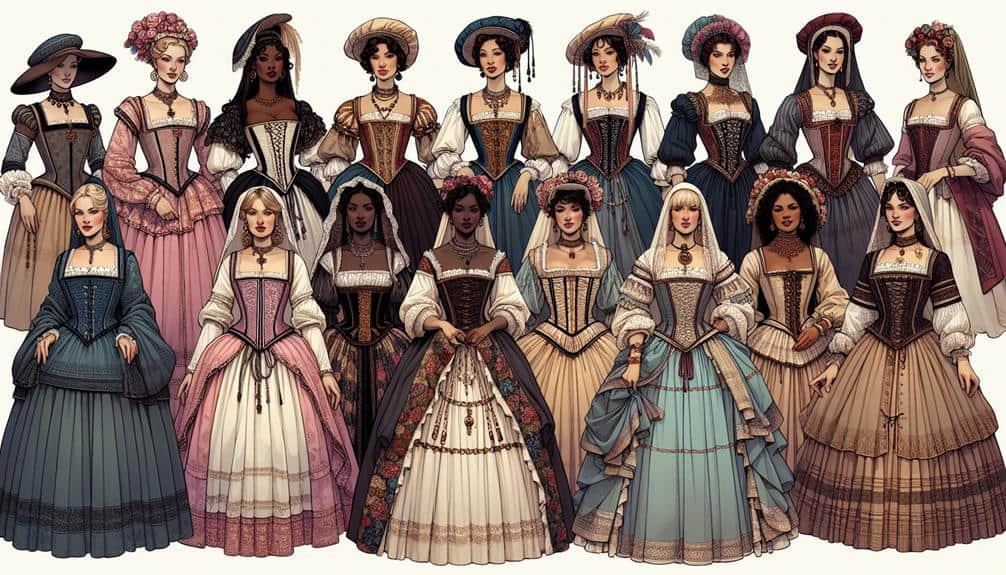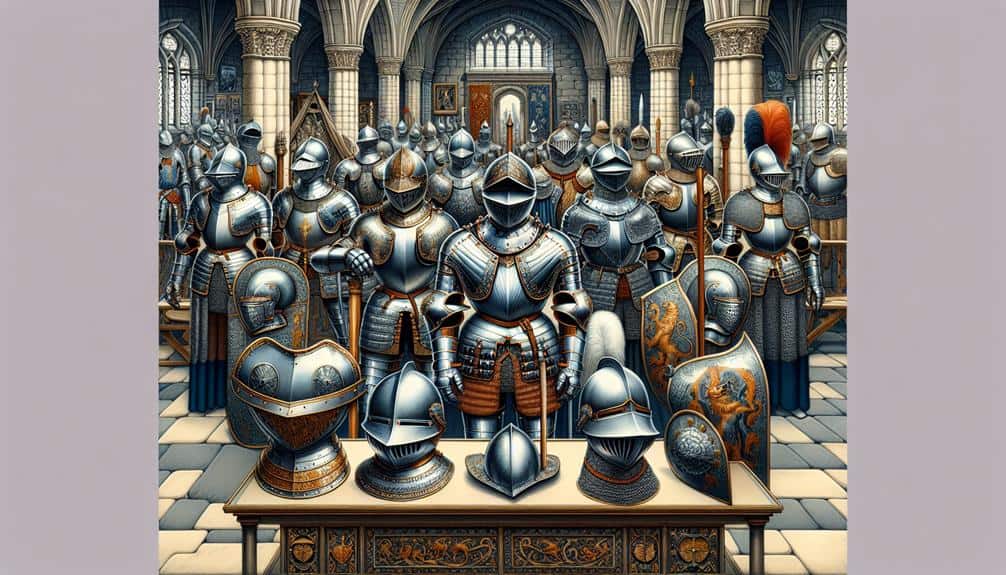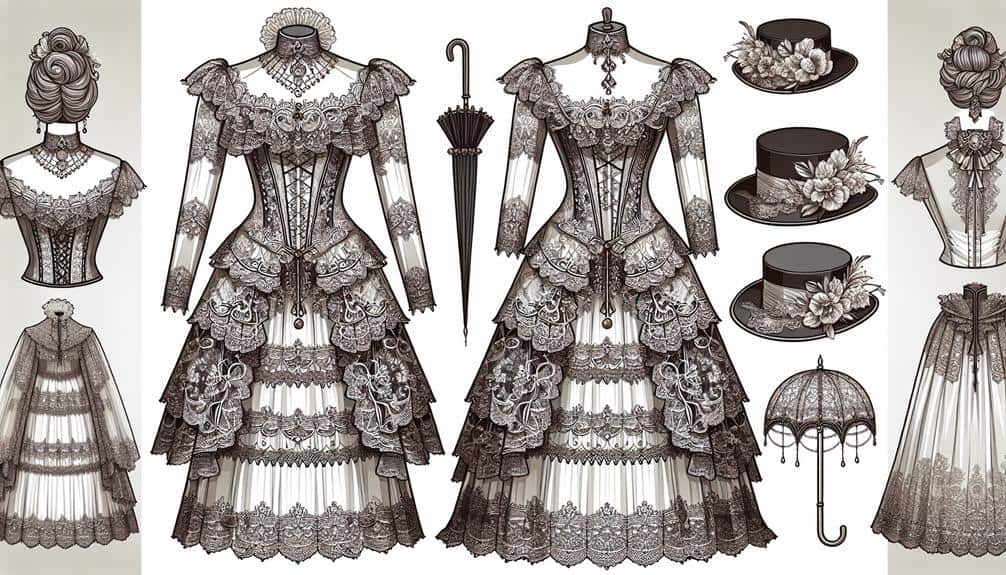To create your own ancient Egyptian pharaoh headdress, gather the materials needed, prepare the base, add decorative elements, include symbolism, and add the finishing touches.
Imagine the intricate designs and powerful symbols that adorned the headdresses of the pharaohs, reflecting their status and beliefs.
As you start crafting your headdress, you'll set off on a journey to not only replicate history but to also experience the artistry and cultural significance firsthand.
Key Takeaways
- Use authentic materials like linen or papyrus for the base and incorporate symbolic motifs
- Select vibrant colors like gold, blue, and red for cultural significance
- Include ancient Egyptian symbols like the Uraeus and Eye of Horus for authenticity
- Pay attention to historical color choices and craft techniques for an authentic headdress
Materials Needed
To create an authentic Ancient Egyptian Pharaoh headdress, you'll need a selection of specific materials that closely resemble those used in ancient times. Historical accuracy is important when choosing your materials. For the base of the headdress, opt for materials like linen or papyrus to mirror what the ancient Egyptians would have used. These materials not only offer historical accuracy but also guarantee the headdress looks genuine.
When selecting colors for your headdress, it's important to think about the hues that were popular in ancient Egyptian culture. Traditional colors such as gold, blue, red, and white were often used in Pharaoh headdresses. These colors were symbolic and held significant meaning in Egyptian society. By incorporating these color choices into your headdress, you can capture the essence of ancient Egyptian royalty.
2. Preparing the Base
Begin by selecting a sturdy and authentic material such as linen or papyrus to serve as the base for your Ancient Egyptian Pharaoh headdress. To create the base, you'll need to measure the dimensions of your head to make a proper fit. Take these measurements carefully to avoid any discomfort when wearing the headdress.
Once you have the measurements, you can proceed to cut a piece of foam following the dimensions you have noted down. The foam will provide structure and support to your headdress, allowing it to hold its shape and sit comfortably on your head.
When cutting the foam, use sharp scissors or a craft knife to make clean edges. Take your time to cut along the measured lines accurately. The foam should be cut slightly larger than the measured dimensions to allow for adjustments and fine-tuning later in the process.
With the foam cut to size, you're now ready to move on to the next step of assembling and decorating your Ancient Egyptian Pharaoh headdress.
3. Adding Decorative Elements
Explore the intricate artistry of Ancient Egyptian culture by incorporating symbolic motifs and luxurious materials into the design of your Pharaoh headdress. When adding decorative elements, consider the color choices that hold historical accuracy. The Ancient Egyptians utilized a vibrant color palette, with hues like deep blues, rich golds, and bold reds symbolizing various aspects of life, such as the Nile River and the sun. These colors not only added visual appeal but also held deep cultural significance.
Craft techniques were vital in Ancient Egyptian artistry, so when embellishing your headdress, consider using methods like intricate beadwork, intricate embroidery, or even hand-painted designs to honor the historical accuracy of the era. The intricate details in these craft techniques were a tribute to the skilled artisans of the time, showcasing their dedication to perfection.
Each decorative element you add should reflect the cultural significance present in Ancient Egyptian society. Symbols like the Eye of Horus, the Ankh, or hieroglyphics can be incorporated to pay homage to the beliefs and values of the civilization, adding depth and meaning to your headdress.
4. Incorporating Symbolism
Incorporate symbolic motifs and meaningful imagery that resonate with the beliefs and values of Ancient Egyptian society into the design of your Pharaoh headdress. Symbolism interpretation played a crucial role in Ancient Egyptian culture, with each symbol carrying deep historical significance. The cobra, known as the Uraeus, symbolized the goddess Wadjet and was associated with protection and royalty. Incorporating a representation of the Uraeus on your headdress signifies authority and divine protection, reflecting the Pharaoh's status as a god on Earth.
Furthermore, the vulture and the cobra, when depicted together, represented the unification of Upper and Lower Egypt under one rule. By including both symbols on your headdress, you not only honor this ancient tradition but also embody the unity and harmony of the Egyptian lands. The use of colors like gold, blue, and red wasn't arbitrary; gold symbolized the sun and the eternal nature of the gods, blue represented the Nile and life, while red signified vitality and power. By carefully selecting colors that align with these symbolic interpretations, your headdress will authentically capture the essence of Ancient Egyptian beliefs and values.
5. Finishing Touches
To elevate the authenticity of your Ancient Egyptian Pharaoh headdress, consider adding intricate details and embellishments that epitomize the grandeur and significance of this regal headpiece. When finalizing your headdress, pay close attention to color choices to guarantee historical accuracy. Ancient Egyptian Pharaoh headdresses often featured colors like gold, blue, red, and white, symbolizing various aspects of the pharaoh's power and connection to the gods. Incorporating these traditional colors will enhance the overall historical authenticity of your creation.
Moreover, explore beading techniques that hold cultural significance in Ancient Egyptian symbolism. Beading was a common embellishment on pharaoh headdresses, representing wealth, status, and protection. Consider using intricate beading patterns to adorn your headdress, paying homage to the craftsmanship and symbolism valued by ancient Egyptians.
Frequently Asked Questions
How Long Does It Typically Take to Make an Ancient Egyptian Pharaoh Headdress?
When making an ancient Egyptian pharaoh headdress, the time commitment varies depending on your crafting skills. Typically, it can take several hours to days to complete. Precise detailing and intricate designs require patience and dedication.
Do I Need Any Prior Crafting Experience to Successfully Make This Headdress?
Crafting skills aren't a must for this headdress project; it's beginner-friendly. You can customize the fit easily. No prior crafting experience is needed to successfully make this headdress. It's adaptable to your skill level.
Can the Headdress Be Easily Adjusted to Fit Different Head Sizes?
Adjustable sizing within the headdress allows for a custom fit to various head sizes. Its versatility and customization options make it accessible to all. This adaptability guarantees comfort and authenticity in recreating this ancient Egyptian Pharaoh look.
Are There Any Specific Historical Accuracy Considerations to Keep in Mind While Making the Headdress?
When considering historical accuracy for an Ancient Egyptian Pharaoh headdress, focus on using authentic materials like linen and gold. Pay attention to design variations and decorations based on historical references to create a culturally appropriate and accurate representation.
How Should the Headdress Be Stored and Maintained to Ensure Its Longevity?
To maintain the headdress's longevity, store it in a cool, dry place away from direct sunlight. Regularly dust with a soft brush and avoid excessive handling. Consider placing it in a protective case or covering to prevent damage.



